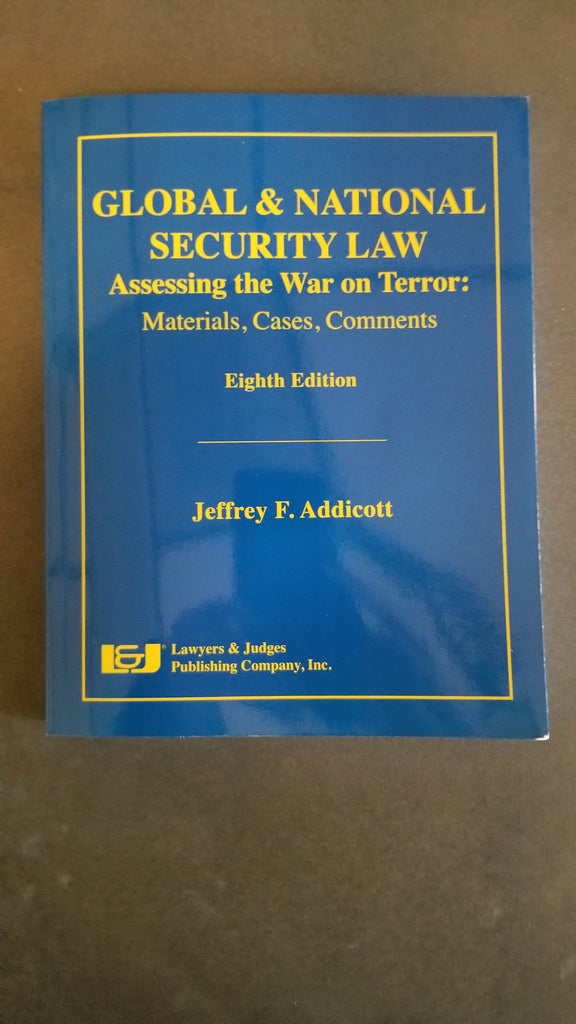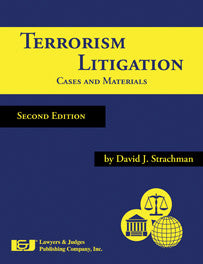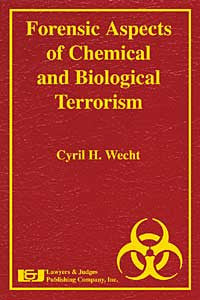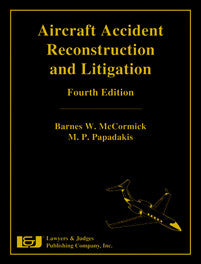
Global & National Security Law: Assessing the War on Terror: Materials Cases Comments, Eighth Edition
• Author: Jeffrey F. Addicott, B.A. J.D. LLM, SJD
• ISBN 13: 978-1-936306-83-3
• Copyright Date Ed: January 17, 2021
• Pages: 332
• Binding Information: Softbound
• Size: 11 X 8.5 Inches (US)
New eighth edition features updated Materials, Cases Comments
As the first edition of Terrorism Law suggests, terrorism, like crime, can never be completely eradicated. Over the past few years, as previous editions were released, the United States has faced many changes and challenges pertaining to the War on Terror, and continues to do so today. Although it was realized at the time the war started that legal and policy challenges would exist, no one could have predicted exactly what events would occur. Much has changed since September 11, 2001 in both the law and policy areas. The biggest challenges have become realistically fighting and winning the War on Terror under a democratically based rule of law, and protecting human rights and civil liberties in an ongoing wartime situation. It has been determined that the United States of America must accomplish three things: identify and appreciate the threat of militant Islamic global terrorism; do a better job of bringing the battle to the terrorists and the nations that harbor them; and promote and sustain a dedicated democracy-building campaign in new governments such as those in Afghanistan and Iraq.
The eighth edition of Terrorism Law has been updated to include new developments in this war, including the Boston Marathon bombing, as well as some of our nation’s and the world’s biggest challenges while fighting it. You’ll find information on cyberterrorism, bioterrorism, effects of the War on Terror on civil liberties, understanding the necessity for the Law of War and the Rule of Law, a new paradigm for war and terrorism avoidance, the role of the military in promoting human rights, interrogation techniques and what defines torture, use of civil litigation in the War on Terror, a history of the War on Terror and why America must stay the course and abide by the Rule of Law when fighting this war. This new edition is designed to be used as a reference text in this emerging area of law. It includes many appendices containing important American and international documents pertaining to the War on Terror as well as discussion questions, citations of legal cases pertaining to terrorism, and bibliographic information for further reference.
TOPICS INCLUDE:
- What is terrorism?
- The goal of terrorism
- State-sponsored and state-supported terrorism
- Sub-state terrorism
- Individual terrorism
- Al-Qa’eda-styled terrorism and Militant Islam
- The War on Terror
- September 11, 2001
- The Rule of Law: use of force
- NATO
- Congressional war-making power
- Presidential war-making power
- The employment of lawful violence
- Expanding the War on Terror
- The Bush Doctrine and the Rule of Law
- Power versus Words: The Rule of Law
- Civil liberties and the War on Terror
- Addressing Terrorism since 9/11
- Federal courts
- Investigating terrorist suspects
- Use of the military in domestic law enforcement
- New information-gathering technologies
- The Constitution and the War on Terror
- Necessity and rationale for the Law of War: lessons from My Lai
- Lesson One: Rationale for the Law of War
- Lesson Two: Soldiers must be trained in the Law of War
- Lesson Three: Preventing violations of the Law of War in the War on Terror
- Interrogation techniques and what is torture
- International agreements
- Allegations of United States sanctioned torture
- Abu Ghraib and the search for the smoking gun
- Contractors on the battlefield
- Cyberterrorism
- Prosecuting cyber attacks
- Cyber as a weapon of war
- Civil liability in the private sector
- Bioterrorism
- Weapons of mass destruction
- A new paradigm for war and avoiding terrorism
- The causes of aggression and terrorism
- Religion and the War on Terror
- Defining democratic values and democracy
- New non-traditional roles: human rights as a force multiplier
- The new paradigm for war and terrorism avoidance
- Leading the way: Pax Americana or the Rule of Law?
- Civil litigation and the War on Terror
- The role of the military and Army Special Forces in promoting human rights
- Why America must stay the course
Table of Contents
Table of Cases
Acknowledgments
Introduction
Chapter 1: What is Terrorism?
1.1 Defining Terrorism
1.2 The Goal of Terrorism
1.3 Terrorism and Weapons of Mass Destruction
1.4 State-Sponsored and State-Supported Terrorism
1.5 Sub-State Terrorism
1.6 Individual Terrorism
1.7 Al-Qa’eda-Styled Terrorism and Militant Islam
1.8 Why They Hate
1.9 Questions for Discussion
Selected Bibliography
Chapter 3: Necessity and Rationale for the Law of War—Lessons from My Lai 3.1 The Law of War
3.2 Voices from the Past—My Lai
3.3 Facts of My Lai
3.4 My Lai Comes to Light
3.5 Impact of My Lai
3.6 Why Did My Lai Happen?
3.7 Leadership
3.8 Lack of a Grand Strategy
3.9 Rules of Engagement
3.10 Lessons of My Lai
3.11 Lesson One—Rationale for the Law of War
3.12 Lesson Two—Soldiers Must Be Trained in the Law of War
3.13 Lesson Three—Preventing Violations of the Law of War in the War on Terror
3.14 Questions for Discussion
Selected Bibliography
Chapter 4: The War on Terror
4.1 September 11, 2001
4.2 An Act of War-The War on Terror
4.3 The Rule of Law—Use of Force
4.4 NATO
4.5 Congressional War-Making Power
4.6 Presidential War-Making Power
4.7 Article III Courts
4.8 The Employment of Lawful Violence
4.9 Questions for Discussion
Selected Bibliography
Chapter 5: Expanding the War on Terror
3.1 The Bush Doctrine
3.2 Weapons of Mass Murder
3.3 Anticipatory Self-Defense and the Rule of Law
3.4 Power versus Words—the Rule of Law
3.5 The Obama Approach to the War on Terror
3.6 Questions for Discussion
Selected Bibliography
Chapter 6: Civil Liberties and the War on Terror
4.1 Past Efforts to Address Terrorism
4.2 Addressing Terrorism Since 9/11
4.3 Detainee Status
4.4 Case Law on Detainee Issues
4.5 Military Commissions
4.6 Federal Courts
4.7 Investigating Terrorist Suspects
4.8 Use of the Military in Domestic Law Enforcement
4.9 Privacy and Immigration
4.10 Privacy and New Information-Gathering Technologies
4.11 Assassination
4.12 The Constitution and the War on Terror
4.13 Questions for Discussion
Selected Bibliography
Chapter 7: Interrogation Techniques
7.1 Defining Torture
7.2 The Torture Convention
7.3 Rendition
7.4 United States Domestic Law
7.5 Allegations of United States Sanctioned Torture
7.6 DOD Interrogation Practices 2002-2005
7.7 CIA Interrogation Policies 2002-2005
7.8 The Ticking Time Bomb Scenario
7.9 Abu Ghraib and the Search for the Smoking Gun
7.10 The HIG
7.11 Conclusion
7.11 Questions for Discussion
Selected Bibliography
Chapter 8: Cyber Warefare
8.1 Defining Cyber Terms
8.2 Cyber Threats
8.3 Government and Private Sector Partnership
8.4 Cyber Attacks and War
8.5 Conclusion
8.6 Questions for Discussion
Selected Bibliography
Chapter 9: Terrorism Avoidance
9.1 The Causes of Aggression and Terrorism
9.2 Religion and the War on Terror
9.3 The New Paradigm for War and Terrorism Avoidance
9.4 Defining Democratic Values and Democracy
9.5 Origins of Human Rights
9.6 The Corpus of Human Rights Law
9.7 United Nations Efforts to Promote Human Rights
9.8 Non-Governmental Organizations Devoted to Human Rights
9.9 Regional Organizations to Promote Human Rights
9.10 Traditional Efforts of the United States in Promoting Human Rights
9.11 New Non-Traditional Roles—Human Rights as a Force Multiplier
9.12 The Role of Special Forces
9.13 New Challenges and New Thinking
9.14 Questions for Discussion
Selected Bibliography
Chapter 10: Leading the Way—Pax Americana or the Rule of Law?
10.1 The United States Global Strategic View
10.2 American Leadership in National Security
10.3 Peace, Freedom and Appeasement—Lessons from the Gulf War of 1991
10.4 Peace, Freedom and Appeasement—Lessons from the War on Terror
10.5 Stay with the Rule of Law
10.6 America Must Stay the Course
10.7 Questions for Discussion
Selected Bibliography
Chapter 11: Civil Litigation
11.1 Tort Liability Against Affected Targets
11.2 Suits Against State-Sponsors of Terrorism
11.3 Proposed International Civil Legal Model
11.4 Conclusion
11.5 Questions for Discussion
Selected Bibliography
Chapter 12: Responses to Bioterrorism and the Legal Ramifications
12.1 Defining Bioterrorism
12.2 Government Responsibilities and Authority
12.3 The Goal of Quarantine
12.4 The Legality of Quarantine
12.5 Search and Seizure
12.6 Other Legal Issues
12.7 Questions for Discussion
Selected Bibliography
Appendix A: Selected Provisions of the Charter of the United Nations
Appendix B: War Powers Resolution
Appendix C: The United States Constitution (Selected Provisions)
Appendix D: Universal Declaration of Human Rights
Appendix E: International Covenant on Civil and Political Rights
About the Author
Index




